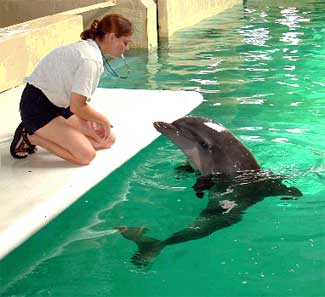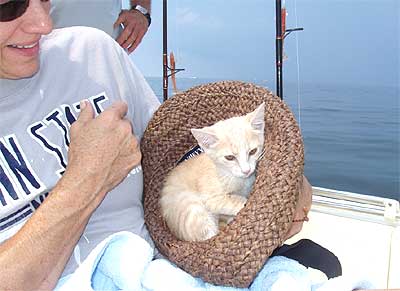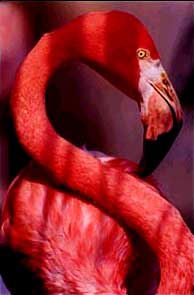Nicholas having a ball in his new home

PHOTO COURTESY OF CMA, 2004
Suffering 3rd degree sunburn the pair was moved by rescuers to the Aquarium on Christmas Eve. The adult, Noelle, died of her injuries a few days later and it appeared likely Nicholas too would succumb to sunburn and infection.Volunteers and staff kept an around the clock vigil with Nicholas who at first began to lose weight without his mother, like other mammals dolphins nourish their young with milk. Aquarium officials concocted a substitute milk and the baby was able to fight off infection and started to gain weight.
At first it took five people to hold the youngster who, when found, weighed 120 pounds while doctors drew blood from his tail to monitor his white cell count and cleaned the large wound near his head.
Sunday, after 18 months of healing, Nicholas along with his new pool-mate Panama moved into their new environment at the aquarium's main dolphin pool . There had been speculation at one time that Nicholas might be returned to the open sea, a stated goal of the CMA's rescue and rehabilitation policy. Considering his long rehabilitation at such an early age permanent residency at the aquarium is the best solution; a truly happy ending for the young dolphin as well as area children who have adopted Nicholas as their own.
You can learn more about the CMA and Nicholas at their website.


 For several years Carcharodon has reigned supreme as the terrible man-eater portrayed by Peter Benchely's novel "Jaws" made into a 1975 movie by the same name. Since then zoologists and their employer zoos and aquariums have been in a feeding frenzy of their own aimed at fueling their institutions coffers with tourist dollars: who would be first to claim the "Great White Prize."
For several years Carcharodon has reigned supreme as the terrible man-eater portrayed by Peter Benchely's novel "Jaws" made into a 1975 movie by the same name. Since then zoologists and their employer zoos and aquariums have been in a feeding frenzy of their own aimed at fueling their institutions coffers with tourist dollars: who would be first to claim the "Great White Prize."












